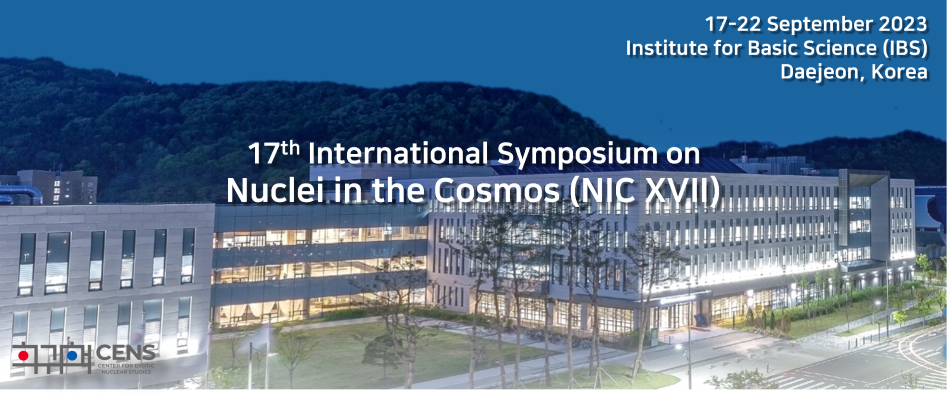Where and how were heavy elements which contain many neutrons relative to proton, synthesized? With regards to the origin of these heavy elements, a reaction in which nuclei capture neutrons in a fast and continuous manner during the explosion of a star was proposed and named the rapid neutron capture process (r process) [1].
In 2017, a binary neutron star merger event was discovered by...
The $^{18}$Ne($\alpha$,$p$)$^{21}$Na reaction is one candidate of the breakout reactions from hot-CNO cycle, and it plays an important role in understanding the X-ray bursts and the nucleosynthesis in the rp-process. We investigated energy levels of the $^{22}$Mg by measuring the $\alpha$ resonant scattering on $^{18}$Ne in inverse kinematics. The $^{18}$Ne rare isotope beam was produced at...
Rapid neutron capture nucleosynthesis (the r-process) produces nearly half of the nuclei heavier than iron in explosive stellar scenarios.
The solar system r-process residual abundances show two peaks located at $A\sim 130$ and $A\sim 195$. Between these peaks lies the Rare-Earth Peak (REP), a distinct but small peak at mass number $A\sim 160$ that arises from the freeze-out during the final...
The rapid (r) neutron-capture process produces half of the elements heavier than iron and is located on the neutron-rich side of the nuclear chart. Conversely, light nuclei on the neutron-deficient side may be produced in the neutrino-driven rapid-proton capture (vp) process. Considering the r-process, promising site candidates such as core-collapse supernovae (CCSNe) and neutron star...
Bound-state $\beta$-decay ($\beta_b^-$-decay) is a radically transformative decay mode that can change the stability of a nucleus and generate temperature- and density-dependent decay rates. In this decay mode the $\beta$-electron is created directly in a bound atomic orbital of the daughter nucleus instead of being emitted into the continuum, so the decay channel is only significant in almost...
Indirect methods play an important role in constraining the astrophysical rates of nuclear reactions. This talk will review several recent indirect studies that provided almost model-independent constraints for the key rates.
Neutron-upscattering enhancement of the triple-alpha reaction responsible for the production of carbon, suggested in [1], was investigated by measuring a time-inverse...
A variety of nucleosynthesis processes operate in our universe, producing elements across the nuclear chart. Using a range of tools and techniques, we can probe the nuclear reactions that comprise these processes. In explosive rp-process environments, direct reactions are possible using gaseous targets such as JENSA, with input from indirect techniques such as transfer reactions on both stable...
The hadronic deexcitation of the Hoyle state in 12C induced by inelastic scatterings of particles can enhance the triple-alpha reaction and the resultant accumulated seed nuclei prevent the synthesis of the heavier elements [1]. Quite recently, neutron-induced deexcitation cross sections were measured experimentally and this effect turns out to be less significant [2]. It therefore is even...
Knowledge of the $^{19}$Ne resonance information near the proton threshold (E$_{x}$=6.410 MeV) is important for studying the $^{18}$F($p$,$\alpha$)$^{15}$O nuclear reaction rate in a classical nova [1-4]. Several states in the vicinity of the proton threshold still have not been observed in $^{19}$Ne but were predicted by assuming isospin symmetry from its mirror state in $^{19}$F [5,6]. The...
I will review the current understanding of the nuclear physics of accreting neutron stars, including the rp-process and processes involving neutron rich nuclei, and their relation to observables such as X-ray bursts and the cooling of transiently accreting neutron stars. This will include new results from experiments on rp-process reactions and measurements related to crust Urca processes,...
We use the type-I X-ray burst models, constructed by the one-dimensional multi-zone hydrodynamic KEPLER code [1], and complying with the burst light curves and recurrence times of the observed GS 1826−24 clocked bursts and SAX J1808.4−3658 photospheric radius expansion (PRE) bursts to investigate the combined impact of the latest 22Mg(α,p)25Al [2], 56Ni(p,γ)57Cu [3], 57Cu(p,γ)58Zn [4],...

